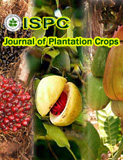Comparative efficacy and residual toxicity of selective insecticides against Helopeltis theivora Waterhouse infesting Cocoa
DOI:
https://doi.org/10.25081/jpc.2023.v51.i3.8558Abstract
Cocoa (Theobroma cacao L.) is an important beverage crop, commercially grown as a plantation crop. In the changed climate-scenario, tea mosquito bug species complex viz., Helopeltis theivora, H. bradyii and H. antonii are emerging as major threat to cocoa cultivation in India. Among these species, H. theivora is responsible for causing substantial crop-damage. The present investigation was carried out to evaluate the toxicity, efficacy, and residual effects of various test-insecticides (Bifenthrin, Clothianidin, Flonicamid, Imidacloprid, Quinolphos and Thiamethoxam) against H. theivora, a major pest of cocoa. The results revealed that bifenthrin exhibited the highest toxicity with an LC 50value of 0.36 ppm, while flonicamid displayed the least toxicity with an LC50 value of 130.20 ppm. Quinalphos exhibited higher toxicity than flonicamid, with an LC50 value of 100.48 ppm. Imidacloprid and thiamethoxam recorded higher toxicity, recording lower LC 50 values of 47.23 and 64.98 ppm, respectively. Clothianidin showed moderate toxicity with an LC50 value of 75.31 ppm against H. theivora. Field experiments assessed the efficacy of the screened insecticides, revealing that bifenthrin and clothianidin were the most effective in managing H. theivora infestations, resulting in the lowest pod infestation percentages of 10.11% and 13.84%, respectively. Conversely, flonicamid exhibited the least effectiveness, with 37.82% pod infestation. Furthermore, this study investigated the residual toxicity of the insecticides in the field. Bifenthrin and clothianidin displayed persistent effects, causing over 25% mortality of H. theivora even up to 30 days after application. Flonicamid, however, showed rapid loss of residual toxicity compared to other insecticides, with less than 25% residual toxicity reported after 10 days. Imidacloprid and thiamethoxam demonstrated more than 25% residual mortality on day 20 after application. In conclusion, this research underscores the varying toxicities and efficacies of different insecticides against H. theivora in cocoa plantations, with implications for effective pest management strategies.
Downloads
References
Ahmed, M. and Mamun, M.S.A. 2014. Tea mosquito bug, Helopeltis theivora Waterhouse (Hemiptera: Miridae): a threat to tea cultivation in Bangladesh. In: Seminar on Tea Pest and Malaria Control Tea Garden Areas in Greater Sylhet Region, Zoological Society of Bangladesh, BTRI, Srimangal, Moulvibazar. 25 September. pp.1-11.
Alagar, M.,and Bhat, K.S. 2017. Comparison of biology of tea mosquito bug, Helopeltis bradyi Waterhouse (Hemiptera: Miridae) on different phonologicalstages of cocoa (Theobroma cacao L.). Journal of Plantation Crops 45(3): 155-161.
DCCD 2020. Cocoa Area, Production and Productivity for the year 2019-20. https://dccd.gov.in/Content.aspx ?mid=1072&tid=1 (accessed 20 March 2021).
Devasahayam, S. and Nair, C.P.R. 1986. The tea mosquito bug Helopeltis antonii Signoret on cashew in India. Journal of Plantation Crops 14: 1-10.
Gurusubramanian, G. and Bora, S. 2008. Insecticidal resistance to tea mosquito bug, Helopeltis theivora Waterhouse (Miridae: Heteroptera) in North-East India. Journal of Environmental Research and Development. 2: 560-567.
Lahive, F., Hadley, P. and Daymond, A.J. 2019. The physiological responses of cacao to the environment and the implications for climate change resilience. A review. Agronomy for Sustainable Developmen t 39 : 5 . https://doi.org/10.1007/s13593-018-0552-0.
Morita, M., Ueda, T., Yoneda, T.,Koyanagi, T. and Haga, T. 2007.Flonicamid, a novel insecticide with a rapid inhibitory effect on aphid feeding . Pest Management Science 63(10): 969-73.
Muhamad, R. and Way, M.J. 1995. Relationship between feeding habits and fecundity of Helopeltis theivora (Hemiptera: Miridae) on cocoa. Bulletin of Entomological Research 85: 519–523.
Ratnam, R. 1961. Introduction of Criollo cocoa into Madras state. South Indian Horticulture 9: 24-29.
Srikumar, K. K., Smitha , S., Kumar, B.S. and Radhakrishnan, B. 2017. Electro-antennographic response of Helopeltis theivora to synthetic pesticides used in tea plantations. Acta Biologica Hungarica 68(4): 358-67.
Sundararaju, D. and John, N.J. 1992. Mass rearing technique for Helopeltis antonii Sign . (Heteroptera: Miridae)-An Important pest of cashew. Journal of Plantation Crops 20: 46-53.
Sundararaju, D. 1984. Studies on cashew pests and their natural enemies in Goa. Journal of Plantation Crops 12: 38-46.
Thube, S.H., Mahapatro, G.K., Mohan, C., Pandian, R.T.P., Apshara, E. and Jose, C.T. 2019. Biology, feeding and oviposition preference of Helopeltis theivora, with notes on the differential distribution of species of the tea mosquito bug species complex across elevations. Animal Biology 70(1): 67–79.
Published
How to Cite
Issue
Section
Copyright (c) 2024 Journal of Plantation Crops

This work is licensed under a Creative Commons Attribution 4.0 International License.







 .
.